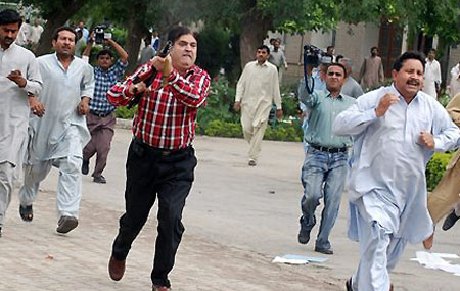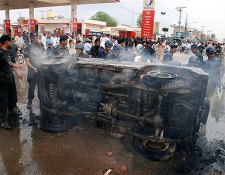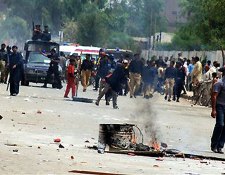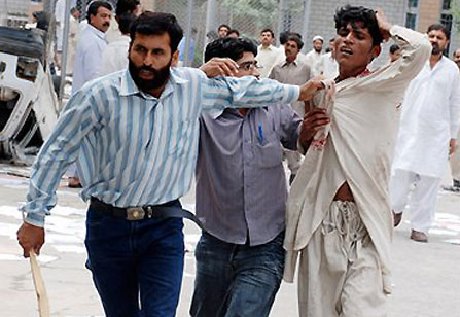Adil Najam
These pictures from the Associated Press are truly astounding (story in Dawn).
Crowds rioted in Multan – the home city of the new Prime Minister Yousuf Raza Gillani – in protest of the massive power cuts because of the growing energy crisis in Pakistan. The office of the Water and Power Development Authority (WAPDA) were ransacked. A dozen cars and buses were set afire. Stones were thrown. A bank was torched. At least 13 people were injured.
The angry man with the gun in the red shirt that you see in the first picture is senior WAPDA official, Mohammad Ishtiaq, opening areal (hawaii) fire to disperse the crowd after about 10 WAPDA workers were injured. In the last picture you see an unidentified WAPDA official grabbing hold of one of the protesters.
This is the “power” politics at its very worst. The real face of energy insecurity. When life is made miserable, anger spills on the streets and so does blood. The senselessness of the violence is only compounded by the senselessness of the energy crisis that triggered the violence. And it is not even summer yet. It promises to be a summer of even greater discontent.























































Rita, I agree. We should use “solar energy” for fans and lights. We need to think out of box to resolve this crisis. There is no easy short term solution to this crisis.
Buildings can be made so that they are naturally cool. It is being done in Bangalore. And solar home systems can power lights and fans. South Asia is blessed with sun and we should use it.
“The senselessness of the violence is only compounded by the senselessness of the energy crisis that triggered the violence”.
I am scared that senselessness of brewing food crises will further exacerbate the violence. Recent FAO report estimates severe shortage of food in more than thirty five countries which may lead to food riots. By the way Pakistan is one of those countries facing food shortage.
A national movement for the conservation of energy and efficiency would be wonderful.
I couldn’t agree with Tina more. We need to promote architecture that provides good insulation and ventillation instead of wasting energy on air conditioning when it can be avoided. The govt should also consider subsidizing insulation materials for rooftops and walls etc as part of its strategy for coping with this crisis.
In addition to this, the per unit electricity bill for housing units should increase very sharply beyond a certain reasonable no of units to discourage excessive use of air conditioning.
Also, school and office hours in peak summer should start as early as 6 AM. At that time, the temperature is more bearable, requiring less airconditioning/cooling. The closing time for schools should then be around 11-12 o’clock and offices can go untill 2 pm or so. That is also a good time to finish because one’s productivity is low due to the peak heat. The afternoon period would then be available for resting, and there would also be more room for people to step out of the house for shopping etc or sports/recreation an hour or two before sunset instead of the night when more electricity consumption is needed for lighting. People will go to sleep earlier in order to wake up before the 6 am office time, and this will reduce the energy load at night too.